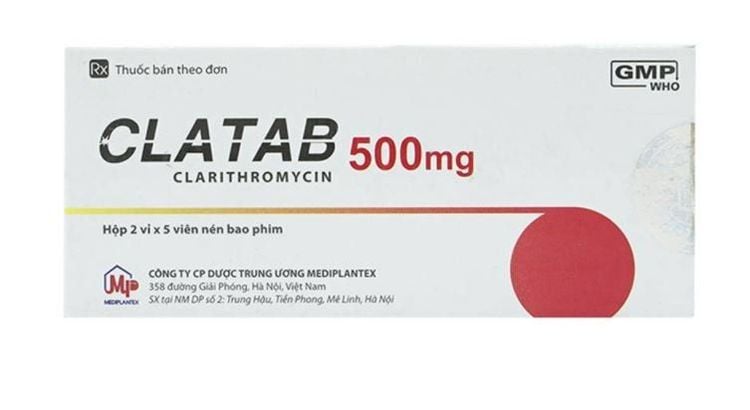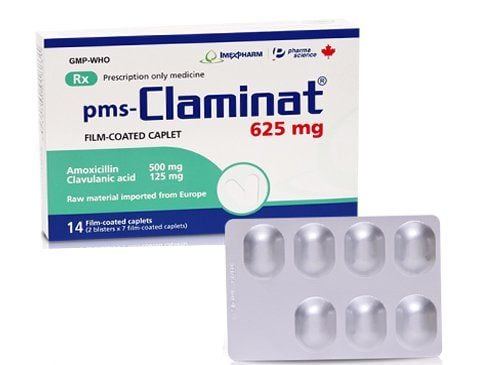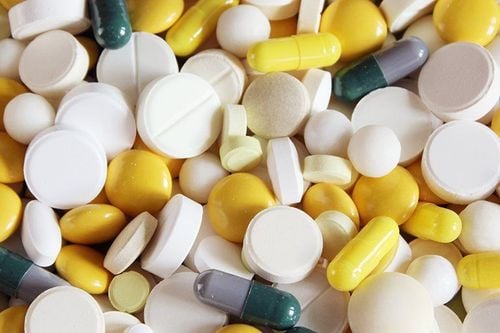This is an automatically translated article.
Clatab 500 has the active ingredient clarithromycin 500 mg. The drug is indicated for the treatment of respiratory diseases and infections. To ensure the effectiveness of treatment and avoid side effects, patients should carefully read the instructions for use before using.
1. What is clatab 500mg?
Clatab 500 of TW Mediplantex Pharmaceutical Joint Stock Company has the active ingredient which is clarithromycin 500 mg. The drug is indicated in the treatment of upper respiratory tract infections, skin and soft tissue infections of mild to moderate severity, superinfection in HIV-infected patients, peptic ulcer disease caused by H.pylori for the following diseases. bacteria are sensitive.
Clatab 500 is also available in film-coated tablets. The main packaging is a box of 2 blisters x 5 tablets.
2. Pharmacodynamics of clatab 500mg
Clarithromycin is a new generation 14C macrolide semisynthetic from erythromycin with a methoxy substituent at the C-6 position of the macrolide ring. Structural changes will help clarithromycin increase lipophilicity, expand antibacterial spectrum, increase tissue concentration, improve stability in acidic media, increase bioavailability and reduce side effects. on the digestive system. Clarithromycin also exerts antibacterial activity by binding to a specific site on the 50s ribosomal subunit of susceptible bacteria, thereby inhibiting protein synthesis in these bacteria. The minimum inhibitory concentration (MIC) of clarithromycin will be 2-4 times lower than the MIC of erythromycin. The 14-hydroxy metabolite of clarithromycin is also more active against H. influenzae. Clarithromycin is highly effective against gram-positive and gram-negative, aerobic and anaerobic bacteria including:Staphylococcus aureus; Streptococcus pyogenes (group A b hemolytic streptococcus); hemolytic streptococcus a (group of viridans) and Streptococcus (Diplococcus) pneumoniae; Streptococcus agalactiae; Listeria monocytogenes, Haemophilus influenzae; Haemophilus parainfluenzae; Moraxella (Branhamella) catarrhalis; Neisseria gonorrhoeae; Bordetella pertussis; Helicobacter pylori; Campylobacter jejuni. Bacteroides fragilis is sensitive to macrolides; Clostridium perfringens; Peptococcus species; Propionibacterium acnes; Mycoplasma pneumoniae and Ureaplasma urealyticum. Clarithromycin is also potent against other microorganisms such as Chlamydia trachomatis; Toxoplasma gondii; Mycobacterium avium; Mycobacterium leprae; Mycobacterium Kansasii; Mycobacterium chelonae; Mycobacterium fortuitum or Mycobacterium intracellulare.

Thuốc Clatab 500mg
3. Pharmacokinetics of clatab 500mg
3.1. Absorption Clarithromycin is rapidly absorbed from the gastrointestinal tract and a high degree of first-pass metabolism reduces the biopharmaceuticals of the parent drug to approximately 55%. Absorption is almost unaffected by food. Peak concentrations of clarithromycin and its major 14-hydroxy clarithromycin metabolite are in the range of 0.6 to 0.7 μg/ml, following a single oral dose of 250 mg. At dynamic equilibrium at the same dose level, the peak concentration is about 1 μg/ml. The pharmacokinetics of Clarithromycin are not linear and will be dose dependent. Large doses produce peak concentrations that increase unproportionately because drug metabolism is saturated.
3.2. Distribution Clarithromycin and its major metabolite are widely distributed and concentrations in tissues exceed serum concentrations because part of the drug is absorbed into the cells.
3.3. Metabolism Clarithromycin is extensively metabolised in the liver and excreted in the faeces via bile. A lesser portion will be excreted in the urine. Approximately 20-30% of the 250 mg and 500 mg doses, respectively, are excreted unchanged by this route.
3.4. Elimination The 14-hydroxy metabolite clarithromycin as well as other metabolites are excreted in the urine. The half-life of clarithromycin would be approximately 3-4 hours following 250 mg twice daily dosing and about 5-7 hours in patients receiving 500 mg twice daily.
4. Uses of clatab 500mg
4.1. The effect of clatab 500mg in this antibiotic formula is also bacteriostatic, in some cases, it will also be able to kill bacteria at high doses or with sensitive strains of bacteria. This substance belongs to the group of macrolide antibiotics and the mechanism of action is to inhibit protein synthesis by binding to the 50S ribosomal subunit. This active ingredient is also active against Gram-positive bacteria: Corynebacterium Diphtheriae, Streptococcus, Staphylococcus,... Gram-negative bacteria: Helicobacter Pylori and some intracellular and opportunistic bacteria such as: Rickettsia, Mycobacterium Kansasii, Mycoplasma,... 4.2. Indications for use of clatab 500mg
In the following cases:
Tonsillitis, otitis media, chronic bronchitis with exacerbations, skin and soft tissue. Pneumonia is caused by Mycoplasma pneumoniae & Legionella, diphtheria, early stage of pertussis, opportunistic infections caused by Mycobacterium. Combination for eradication of Helicobacter pylori in peptic ulcer.
5. How to use clatab 500mg
5.1. How to take clatab 500mg Take orally. It can be used before or after a meal because food does not affect the bioavailability of the drug.
Dosage:
Adults and children over 12 years old
When infections of the respiratory tract, skin and soft tissues:
The usual dose is 250 mg x 2 times / day, for 7 days. In severe infections, the dose may be increased to 500 mg twice daily and treatment may be prolonged up to 14 days.
When peptic ulcer due to H. pylori infection:
Take 1 tablet x 2 times a day, a course of treatment lasts 7-14 days, depending on the combination treatment formula.
Mycobacterium infections:
Initially 500 mg x 2 times a day for 3-4 weeks, if not effective can increase to 1000 mg x 2 times / day.
Patients with renal impairment
Halve the total therapeutic dose and should not be used for more than 14 days.
Note: The above dose is for reference only. The specific dose will depend on the condition and the progression of the disease. To get the right dose, you need to consult your doctor or pharmacist for advice.

Người bệnh nên sử dụng thuốc clatab 500mg đúng liều lượng
5.2. What to do in case of missed dose or overdose Missed dose:
Taking large amounts of clarithromycin can lead to gastrointestinal symptoms. If an overdose is taken, the patient must be hospitalized, gastric lavage and other supportive measures applied. Serum concentrations of clarithromycin are not affected by hemodialysis or peritoneal dialysis.
Overdose:
Symptoms: Overdose may experience symptoms of gastrointestinal disorders (abdominal pain, nausea), pseudomembranous colitis, reversible deafness, Steven - Johnson syndrome, ..
Treatment: It is necessary to immediately stop the drug when experiencing the above symptoms, immediately notify the doctor for appropriate treatment measures. Combined with symptomatic treatment and recovery support.
6. Contraindications of Clatab 500mg
Clarithromycin is contraindicated in patients with a history of increased hypersensitivity to macrolide antibiotics. There is no need to give clarithromycin with ergot derivatives. Contraindicated when using clarithromycin with any of the following drugs: cisapride, pimozide and terfenadine. Increased concentrations of cisapride, pimozide and terfenadine have been reported in patients receiving both these drugs and clarithromycin. This can lead to QT prolongation and arrhythmias, including ventricular tachycardia, ventricular fibrillation, and torsades de pointes. Similar effects have been observed with concomitant administration of astemizol and other macrolides. During pregnancy and while breastfeeding. The safety of clarithromycin during pregnancy and breastfeeding has not been established. Therefore, it should not be used during pregnancy or lactation unless the benefits outweigh the risks. Several studies in animals have suggested embryotoxic effects, but only at doses with obvious maternal toxicity. Clarithromycin was not detected in the milk of lactating animals and in breast milk.7. Side effects of clatab 500mg
Although clarithromycin is generally well tolerated, as with all medicines, it can lead to some side effects in some people. In the course of taking the drug may encounter a few side effects as follows:
Common: Digestive disorders, allergies, urticaria and rashes. Uncommon: Epigastric pain, nausea, vomiting, eosinophilia, jaundice and typhus. It is important to inform your doctor immediately when you experience the above side effects for the best treatment. Very rare: Severe liver dysfunction and fatal liver failure. Frequency unknown: Urticaria, mild rash, anaphylactic reactions and, rarely, Stevens-Johnson syndrome in particular susceptible sites. Pseudomembranous colitis, liver dysfunction will include laboratory changes, hepatitis with or without associated jaundice but is usually reversible. When experiencing side effects of the drug, it is necessary to stop using it and notify the doctor or go to the nearest medical facility for timely treatment.
8. Note when using clatab 500mg
Use on pregnant women and nursing mothers : Use with caution. Use only when absolutely necessary and under the guidance of a doctor.
Other special note: Must be careful when using for people with liver failure, kidney failure.
Storage conditions:
Temperature below 30 degrees Celsius. Protect from light. Keep out of sight and reach of small children. Do not use after the expiry date on the package Clatab 500 has the active ingredient clarithromycin 500 mg. The drug is indicated for the treatment of respiratory diseases and infections. To ensure effective treatment and avoid side effects, patients should carefully read the instructions for use before use or consult a doctor or pharmacist.
Follow Vinmec International General Hospital website to get more health, nutrition and beauty information to protect the health of yourself and your loved ones in your family.
Please dial HOTLINE for more information or register for an appointment HERE. Download MyVinmec app to make appointments faster and to manage your bookings easily.













